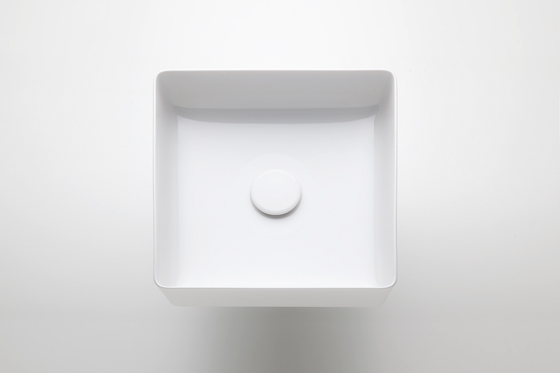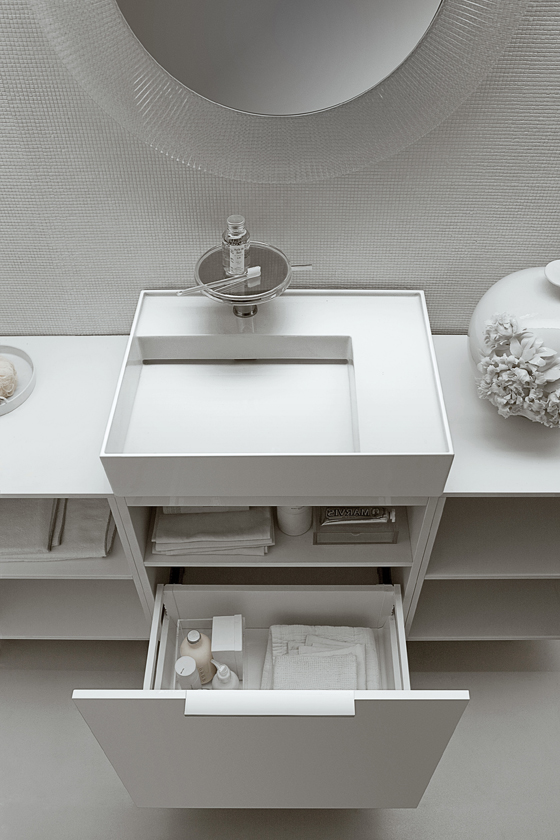Walk the Line
Historia de la marca de Simon Keane-Cowell
Laufen, Suiza
10.11.13
Why do manufactured products look the way they do? Often it’s practical necessity. Sometimes it’s aesthetic tradition. In the case of sanitaryware, it’s due historically to the materials limits of Vitreous China and Fine Fire Clay. Enter SaphirKeramik, a new material innovation from leading Swiss manufacturer LAUFEN that is set to change the bathroom landscape.
The name has it: the key component in Swiss sanitary manufacturer Laufen’s revolutionary new SaphirKeramik is corundum, a mineral found in the precious stone sapphire

The name has it: the key component in Swiss sanitary manufacturer Laufen’s revolutionary new SaphirKeramik is corundum, a mineral found in the precious stone sapphire
×Form follows function, the 19th-century American architect Louis Sullivan famously wrote.
His economically expressed tenet, mirroring his belief that good design itself should be utilitarian and economical in its expression, was to become one of the cherished principles of the Modernists in the first half of the 20th century, underpinning their project to establish their pioneering, highly rational work as the international standard for architecture and design.
But form has, in the history of design-manufacturing, also been determined to a large extent by the properties of the materials chosen to turn ideas into physical objects. Attempting to push a material to its limits, to make it do the bidding of the designer, has often been, in reality, an exercise in compromise.
Surpassed only by diamond in terms of hardness, corundum lends Laufen’s innovative new ceramic an unparalleled hardness, permitting sanitaryware designs with ultra-rational, thin-walled forms
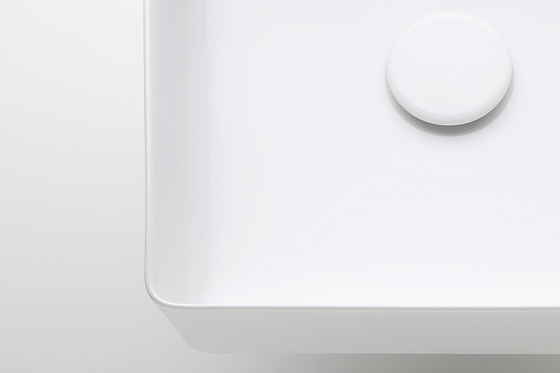
Surpassed only by diamond in terms of hardness, corundum lends Laufen’s innovative new ceramic an unparalleled hardness, permitting sanitaryware designs with ultra-rational, thin-walled forms
×The advent of innovative new materials – such as the proliferation of mass-produced plastics in the post-war period – has allowed us of course to populate our everyday landscapes with forms that were hitherto difficult to realise. But certain product types require, for reasons of practicality, economy, durability and aesthetics, the use of certain traditional, long-established materials, ones that come with a set parameters on what’s possible in terms of form-giving.
One such group of products is sanitaryware, which has long been fabricated from ceramic material. Fired, unglazed vitreous china possesses an unbeatable level of waterproofness (and, by extension, hygiene), with its water-absorption level practically zero. No wonder then that it has for generations been the material of choice for WCs and urinals, and is, in fact, the only approved material for their production. But vitreous china, which shrinks by about 10% in the drying and firing process, isn’t the easiest stuff with which to work. Moreover, form has traditionally been required to follow material here, as the shapes of products rendered in vitreous china have more often than not been those the material itself permits – full, rounded and flowing.
With their emphasis on line, Laufen’s newly launched products in SaphirKeramik also form a dialogue with the interior-architectural spaces in which they are installed
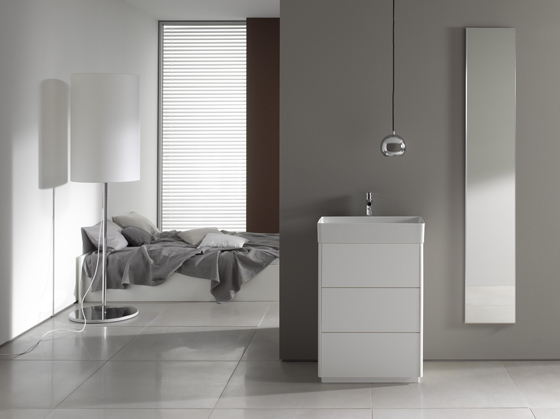
With their emphasis on line, Laufen’s newly launched products in SaphirKeramik also form a dialogue with the interior-architectural spaces in which they are installed
×But then a game-changing material innovation comes along and a whole new, far more elevated design language is born.
The result of five years of intensive development, involving numerous experiments and stringent testing, Swiss sanitaryware manufacturer Laufen has pioneered a new kind of ceramic material, whose unprecedented durability and plasticity is transforming the bathroom landscape. SaphirKeramik for the first time permits ultra-rational, strongly rectinlinear forms whose confident, almost graphic visual presence helps define the interior-architectural spaces in which they are installed. Where once there was the curve, now there’s the tight edge-radius. Fuller forms have given way to delicate, but robust, filigree walls. Thin is in.
‘I’ve been involved in the making of sanitaryware for over 25 years,’ says Laufen’s Research Director Dr Werner Fischer. ‘And in that time there’s been a huge development in terms of changing and improving design. But there’s never been a change in materials. It’s always been Vitreous China and Fine Fire Clay. In all other disciplines of product development, the materials have changed. That was the start of my thinking: to create a new material that offers greater strength, with a reduction in weight, but one that also gives the designer more freedom to do something new. If you give them this freedom, they’ll take it.’
The result of a collaboration with respected Italian design brand Kartell, the new Kartell by LAUFEN collection of products features formally reduced, visually strong, washbasins, made from SaphirKeramik
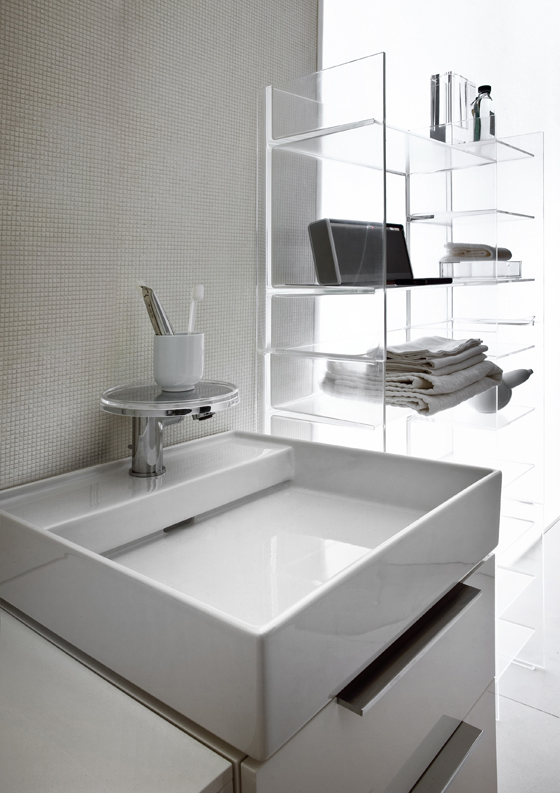
The result of a collaboration with respected Italian design brand Kartell, the new Kartell by LAUFEN collection of products features formally reduced, visually strong, washbasins, made from SaphirKeramik
×The clue is in the name. SaphirKeramik’s impressive technical performance is achieved thanks to a key component of its cutting-edge formulation: the mineral corundum, which manifests itself in nature in the precious stone sapphire. Colourless in its unadulterated form (it’s the presence of other elements, such as iron and titanium, that lends sapphire its distinctive blue hue), corundum, or AI2O3 to the more chemically minded, delivers on two levels. Firstly, it becomes ultra-white when mixed with clay, resulting in sanitary products with a remarkable brilliance. But it also happens to bring with it a hardness that is trumped only by that of diamonds. No wonder then that it is used in the timepiece industry for watch glasses.
Fischer’s determination to drive change in the sanitary sector via material innovation led him to undertake a series of tests to ascertain the benefits of using corundum, as well as to establish a basic formulation. From here it was over to the Laufen factory for prototyping. Using small-scale equipment, a range of items were made that were then put through their paces, subjected to the manufacturer’s standard testing regime. Furthermore, at the Keramik Institut Meißen, bending jigs were used to measure the force the samples could withstand before fracturing, while their edge strength was determined by means of an impact test, involving the dropping of a 190g steel ball onto the edge-radius of the ceramic pieces.
Material innovation SaphirKeramik took five years to develop. ‘We wanted to create a new material that offers greater strength, with a reduction in weight, but one that also gives the designer more freedom,’ says Laufen’s Dr Werner Fischer
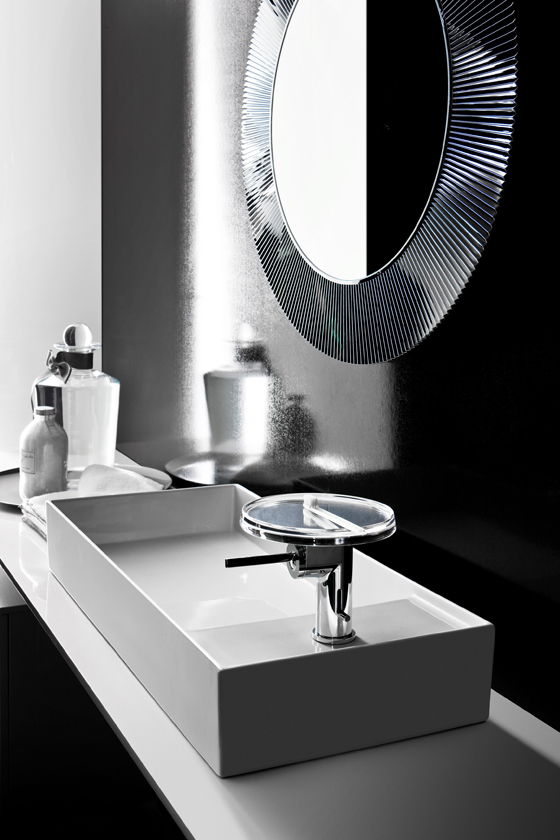
Material innovation SaphirKeramik took five years to develop. ‘We wanted to create a new material that offers greater strength, with a reduction in weight, but one that also gives the designer more freedom,’ says Laufen’s Dr Werner Fischer
×Testing was repeated once the material had been run through normal production, with the formula modified after each test until the optimal recipe, as it were, was reached. The effort involved, not only on the part of Fischer and the development team, but also those working on the production side of things, in such a protracted and iterative process was a substantial one, but the result is more than ample reward. The Federal Institute for Materials Research and Testing in Berlin (BAM) found the flexural strength of SaphirKeramik to be over twice that of vitreous china and on a par with steel.
Perfecting a super-strong ceramic material that allows itself to be fashioned along minimal, architectural lines was only one part of challenge for Laufen, however. It had to be workable with existing production technology, going through the same moulding processes as vitreous china. ‘It was very important that we could cast it under normal circumstances,’ explains Fischer, ‘involving standard production methods and a normal kiln with normal temperature-time curves. And all to our high quality standards.’
New creative standards have been set, too, with the first series of products to be fabricated from SaphirKeramik. With phenomenally narrow edge-radii of 1 to 2 millimetres (the absolute minimum up until now has been 7 to 8), Laufen’s ‘Living Square’ washbasins, together with its bowls for its collaboration with respected Italian design brand Kartell (entitled Kartell by LAUFEN), effect a major shift in the way we imagine and experience the bathroom environment, their line-driven yet expressive forms creating a strong dialogue with the architectural space around them. This is sanitaryware that works way beyond its utilitarian function.
Rigorous testing and independent assessment has resulted in a material that sets a new standard in the design of sanitaryware. Edge radii of just 1 to 2 millimetres are now possible, whereas before the minimum was 7 to 8
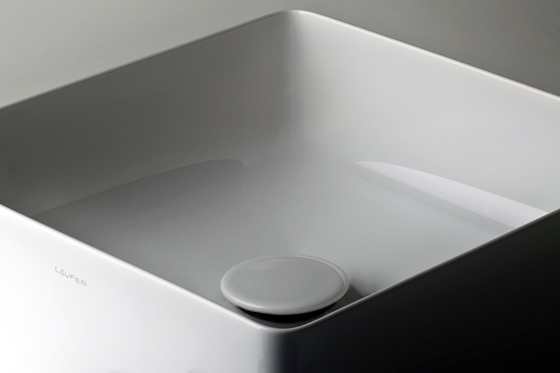
Rigorous testing and independent assessment has resulted in a material that sets a new standard in the design of sanitaryware. Edge radii of just 1 to 2 millimetres are now possible, whereas before the minimum was 7 to 8
×If you listen carefully, you can hear the sound of a quiet revolution and it’s coming from the bathroom.
....


